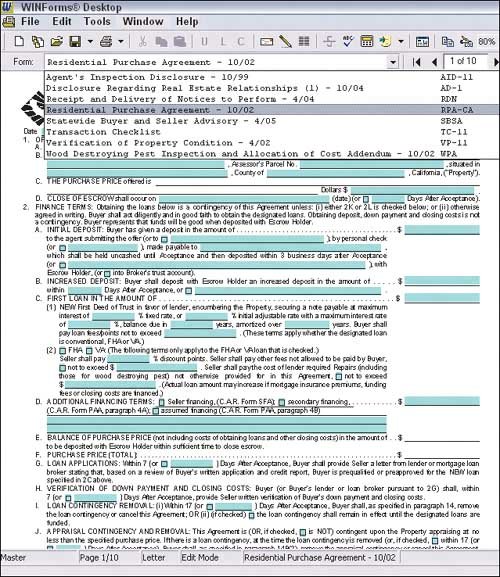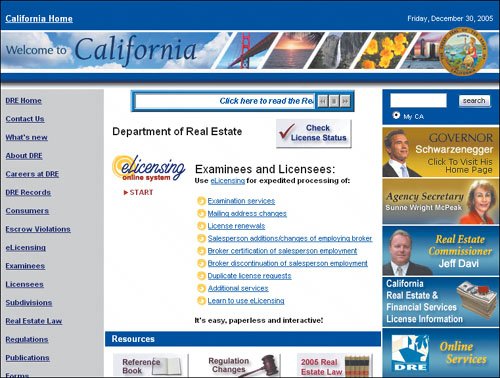| According to the National Association of Realtors, about 300,000 agents use electronic formsto fill in details in their offers, disclosures, and other transaction documents. That's less thana third of all agents. Those 700,000 folks still using paper are missing out on something good. Whether you use software on your computer that lets you enter transaction details or use Web-based forms, these tools provide the following benefits: Readability: Information you enter is readable, so there's less chance of error or misinterpretation. Consistent data: Information that is used repeatedly in a document, such as a person's name or the property address, needs to be entered just once, saving you a lot of work and ensuring the information is consistent on all forms. Reduction of errors: Mathematical errors are reduced, sincethese forms check to make sure that, for example, the down payment amount and financed portion of an offer add up to the offer price. Onscreen preview: The forms can be exported to PDF format, so your clients can review them onscreen before printing them out for signing. This lets you save paper by correcting mistakes or making changes before you print them for signature. Availability: Because the forms are stored on your computer or on the Web, you don't have to worry about running out of them, as you do with the paper form. Up-to-date forms: As the forms are updated by your local Realtors association, you automatically have the most recent version available, ensuring you're using the right form seach time.
Resources For Out-Of-Area Transactions Occasionally, you'll do business outside your areasuch as in another part of your state or, more rarely, in another state. (Remember, you typically need a license in any state in which you sell real estate. The book's companion CD has a link to a National Association of Realtors' Web page where you can check if your state's license is valid in other states.) Because different regions within a state can have different contracts than you use and because they almost certainly use a different MLS system, it can be hard to conduct business in a "foreign" area. (That's why so many agents refer clients to a local agent in an area for a referral fee of 20 to 30 percent.) But if you do choose to work out of area, there are a few resources that can help: Realtor.com: The www.Realtor.com Web site shows listings across the country, letting you get a sense of what's onthe market. Note that the data is often a few days to a few weeks out of date, and you can't look up sales prices, so the information is not complete enough to determine a listing or offer price. MLS systems: Some MLSs cooperate with other nearby ones, providing a way for agents to search for current and sold properties in those neighboring areas. In the San Francisco Bay Area, for example, four local Realtors associations have set up www.mlslistings.com to provide joint search capability. Brokerages: Some large brokerages offer their own MLS search capabilities through a Web site available only totheir agents. Typically, you can search any MLS system in which the brokerage has offices to see current and sold listings. Title companies: If the title company you often do business with offers you online access to title records, youcan check recent sales prices for specific properties or areas. However, this data is typically 30 to 60 days old, since it comes from public records, and it won't list properties currently for sale or display the offer prices for those that were sold. Other providers: You can buy paper or electronic real estate forms for other parts of the country from providers such as TrueForms.
|
Transaction Forms The most common type of electronic forms is transaction formsthe contracts, addenda, and disclosures used to sell and buy homes. To work with these forms electronically, your local Realtors association, or the company that produces its transaction forms, needs to make them available in a computer format. Some companies use their own software to provide these interactive forms, such as Realfast's Realfast and RE FormsNet'sWinforms/Zipforms; these companies also have a Web-based interface so you can log in from any computer and complete the forms. You typically get access to these forms as part of your Realtor membership or for an extra fee. (RE FormsNet is actually a joint subsidiary of the California Association of Realtors and the National Association of Realtors.) Like the paper forms, they're typically not available to nonmembers. Some companies provide forms in PDF format that you can complete using the free Adobe Reader or printout and complete by hand. You typically buy these forms individually and are allowed to complete a specific number of transactions for each purchase. An example is TrueForms, which provides PDF forms for 18 regions, as well as a generic form for use anywhere. PDF forms often are not customized for specific states or regions, as are the forms provided to agents by their Realtors associationin fact, they're typically used by do-it-yourself buyers and sellers looking for a generic, "standard" form. Check with your broker to see if you should be using these generic forms, since they may not meet your errors-and-omissions insurance's requirements.
Real estate forms software, such as Winforms shown here, lets you easily enter details in transaction forms.  You'll also find PDF and Word forms for rental property management, such as leases and pay-or-quit notices from avariety of companies, such as Kaktus and Socrates. If you use such forms, be sure they addressor you have an attorney add language to coverlocal requirements such as rent control, noise ordinances, and occupancy limits. A good source for localized forms is the Apartment Owners Association, which has local chapters in many areas.  CD Resources: For real estate forms, links to Realfast, RE FormsNet, and TrueForms. For rental property forms, links to the Apartment Owners Association, Kaktus, and Socrates. CD Resources: For real estate forms, links to Realfast, RE FormsNet, and TrueForms. For rental property forms, links to the Apartment Owners Association, Kaktus, and Socrates.
Transaction Systems In late 2005, Real Estate Business Technologies (REBT)like RE FormsNet, a subsidiary of the California Association of Realtors and of the National Association of Realtorslaunched an online transaction management system meant to help automate more than just the data entry of transaction forms. The Relay Transaction Management system is available foran annual fee and works with Winforms/Zipforms and many MLS systems, so it can exchange data among them. For example, if you have a listing, the online version of Winforms/Zipforms would get the seller information from Relay, as would the local MLS system.
The new Relay Transaction System provides a central, Web-based service to manage transaction forms, documents, client and agent communications, and even reminders for due dates.  But the Relay system alsoacts as a communications hub, logging all e-mails between you and your clients, and with other parties. Plus, it provides fax-to-PDF conversion, so any documents faxed to a special number are converted to PDF files and stored along with your other transaction documents in the Relay system. And it can also send automated reminders as deadlines approach. Other Agent Resources There are certainly many Web-based ways to help clients and to help agents serve their clients. But there are also Web resources to help agents exclusively. For example, the National Association of Realtors has a Web site specifically for agents: www.realtor.org. Once you sign up, you can access agent and broker-specific resources such as past issues ofRealtor Magazine, technology tutorials, Zipforms electronic transaction forms, membership dues payment, and e-mail newsletter subscriptions. Likewise, your local Realtors association likely also offers Web-based services in addition to MLS access (for those associations that manage their own MLS systems) and agent directories. For example, my local association provides a training calendar and summaries of legal rulings. Many states offer e-government services that let you renew your real estate license, access rules and regulations, and get links to approved continuing education courses. You can go to your state's Web site by entering www.xx.gov in your browser, where xx is replaced by your state's two-letter postal code (such as CA for California or ME for Maine). Search for the Department of Real Estate or whatever it's called in your state. Then bookmark the appropriate page in your browser. Don't forget to use the Web the way your clients do: as a resource for consumers. For example, it can be less expensive to have your business cards printed by a Web-based service than to use your brokerage's service. Or you can save money, or get a more attractive version, when buying business cards online than at a store. In addition to shopping, you can use the Web to manage your bank accounts and other transactions, both business and personal.
Many states, such as California, offer agents and brokers licensing and other services via the Web.  |
The idea is to give you a central management tool for your transactions, combining many of the technologies mentioned in this chapter into one system. That's a great concept, especially if you don't want to manage all the technology tools yourself but just want to manage the transactions. Because it's so new, few agents are using Relay, and only a few MLSs can connect to it, so check whether it supports your MLS before you buy a service subscription. Personally, I'm leery about a Web-based service storing my transaction data, since I no longer have control over it, but then again if my computer crashes and loses data, anything stored on Relay is unaffected. Another issue to consider is that you must have an Internet connection to use it, so you couldn't work on transaction forms on your laptop during a slow open house, for example, unless you have a 3G wireless connection (as covered in Chapter 2, "The Right Connections"). However, I suspect that over time such a system will become commonplace, offered through your Realtors association (as Relay is) or as a service from your brokeragesomething a few large brokerages also offer today.  CD Resources: A link to REBT. CD Resources: A link to REBT.
|


